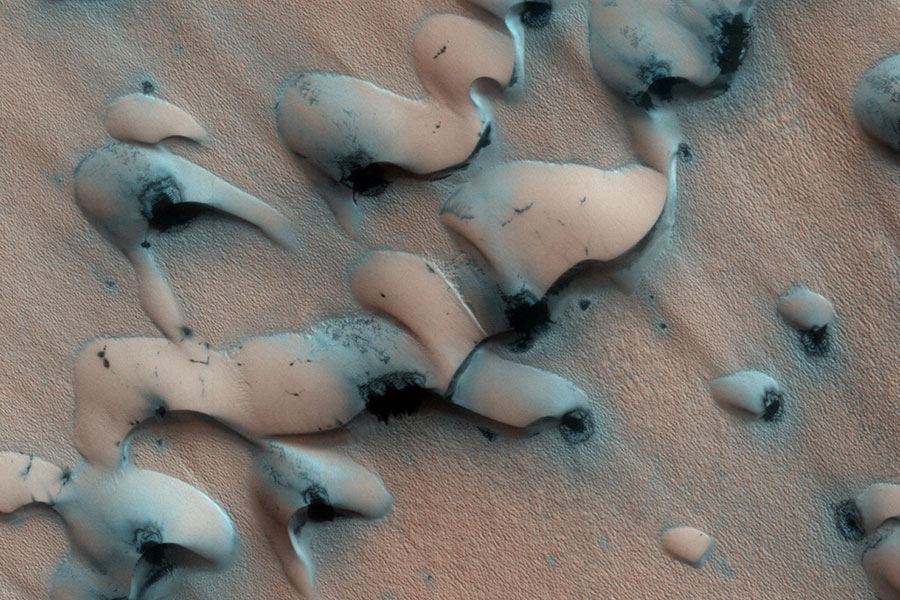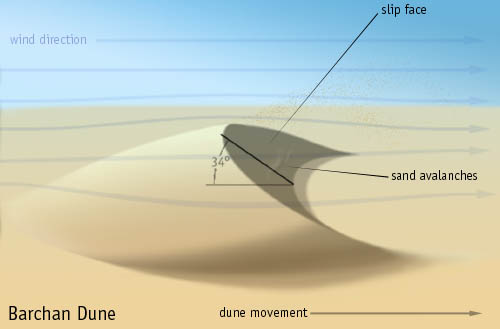
So what are those marks that look like impacts? Is that the exploding that happens when the sand thaws?
Very interesting image. =)The process might even involve sandy jets exploding through the thinning ice.

Very interesting image. =)The process might even involve sandy jets exploding through the thinning ice.
Many of the "sandy jets" seem to occur near the pinnacle of the barchan dunes.Arramon wrote:So what are those marks that look like impacts? Is that the exploding that happens when the sand thaws?Very interesting image. =)The process might even involve sandy jets exploding through the thinning ice.
For a barchan dune to move and still maintain it's characteristic shape there must be maximal sand depletion on the steepest part of the front slope in conjunction with maximal sand deposition on the steepest part of the back slope. Presumably it is these steep regions (rather than the flat top) that represent the points of maximal & minimal wind stress (and to some extent of maximal & minimal surface wind speed) respectively.kovil wrote:The dark spots or areas, look to be the place where the wind velocity would be highest passing over the dune shape. This might be why it thaws there first, and the most 'snow' is also blown away along that track.
There will be a vortex line in the wake of the ridge of the dune but this vortex line will have a significant vertical (i.e., tornadic) component only on the right & left sides of the dune.kovil wrote:It might be because the wind makes a small tornado as it passes over that cresting point, and that also stirs the snow away.

Sorry, I should have been more specific:Delysid23 wrote: If by "front slope" neufer means the slope on advancing side of the movng dune, i.e. the side in the direction the dune is moving, it is the overhung steep slope, facing away from the wind. This would make the "back slope" the long shallow slope facing toward the wind.
There certainly could be random hot spots of vapor release that interact with passing dunes in complex non linear ways. As layers of falling sand on the 34º face cover up these hot spots vapor release (preferentially following micro-cracks between the slip layers?) could induce more slippage and actually nudge the center of the dune towards these hot spots until the "big mess" you refer to occurs.Delysid23 wrote:Finally, another hypothesis re the dark crater/jet holes most evident on the crest of several dunes -- could it be that they're jets popping up randomly that do so with little fuss and are quickly and lightly covered over in flat non-dune-covered areas, but that build up pressure and make a big mess when bursting through a thick cover of sand, thickest when the ridge of a dune is over them? In other words, the dunes don't cause the jets but just make them more explosive and visible events.
http://en.wikipedia.org/wiki/ArrakisArramon wrote:In other words, don't play on the dunes once we get there. =b
So I guess sandworms are out. O.o
These couldn't be melange spice fields going up? A good spice blow?
hehehe.... no , i guess not.
d'oh! no arrakis for us.


One can guess on where it goes from the picture itself:JohnD wrote:Where does the black/dark blue material come from, where does it go and how is it re-concentrated under the barchans for the next winter? John
Sand Dunes Thawing on Mars (APOD 2008 March 03) suggests the same:geonuc wrote:As to the dark material that 'spots' the tops of the dunes, a previous APOD seems to suggest the dune sand itself is dark and what we're seeing is the initial points of thawing at the top of the dunes. Or something like that.
...Thinner regions of ice typically defrost first revealing sand whose darkness soaks in sunlight and accelerates the thaw...
Those images don't appear the same. The newer one shows only dark spots near the crest of the dune, where it falls to the side blocked by the wind. They look like explosions. Just wondering what chemical reactions cause this besides what the explanation was in the APOD summary. Are there processes on earth that create these similar outward bursts on this same type of frozen dune?geonuc wrote:As to the dark material that 'spots' the tops of the dunes, a previous APOD seems to suggest the dune sand itself is dark and what we're seeing is the initial points of thawing at the top of the dunes. Or something like that.
http://apod.nasa.gov/apod/ap040831.html
I lack the experience with frozen dunes, the last time i saw frozen dunes, was in 1963, in my childhood. What i can tell from a more recent experience: an odd five years ago experiments were performed by injecting liquid oxygen (90.2 K) into the soil, i.e. silt (d < 63 μm) and aeolian sands. Since the oxygen was injected a depth of a few meters, no blow out occured. Just cracks in the soil. The effective stress in the soil at a depth of 5 m was too high to allow for a blow out.Arramon wrote:Are there processes on earth that create these similar outward bursts on this same type of frozen dune?
The ice of carbon dioxide i know is milky white, not as transparent as water ice. Maybe there exists a transparent form of CO2 ice at pressures as low as on Mars. I'm not familiar with that specific transparent form.JohnD wrote: The soil/sand below the water/co2 ice must be dark, very dark if it is the materail thrown upwards by the geysirs. If the ice was transparent,
JohnD wrote: would sunshine penetrate to the dark soil and heat that, beneath the ice? So the ice began to sublime from the bottom up?
http://www.youtube.com/watch?v=PNm1kfxl ... re=relatedArramon wrote:http://apod.nasa.gov/apod/ap080303.html
So what are those marks that look like impacts? Is that the exploding that happens when the sand thaws?
The process might even involve sandy jets exploding through the thinning ice.

